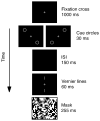Where does attention go when it moves? Spatial properties and locus of the attentional repulsion effect
- PMID: 21047765
- PMCID: PMC2998340
- DOI: 10.1167/10.12.33
Where does attention go when it moves? Spatial properties and locus of the attentional repulsion effect
Abstract
Reliable effects of spatial attention on perceptual measures have been well documented, yet little is known about how attention affects perception of space per se. The present study examined the effects of involuntary shifts of spatial attention on perceived location using a paradigm developed by S. Suzuki and P. Cavanagh (1997) that produces an attentional repulsion effect (ARE). The ARE refers to the illusory displacement of two vernier lines away from briefly presented cues. In Experiment 1, we show that the magnitude of the ARE depends on cue-target distance, indicating that the effects of attention on perceived location are not uniform across the visual field. Experiments 2 and 3 tested whether repulsion occurs away from cue center of mass or from cue contour. Perceived repulsion always occurred away from the cues' center of mass, regardless of the arrangement of the cue contours relative to the vernier lines. Moreover, the magnitude of the ARE varied with shifts in the position of the cues' center of mass. These experiments suggest that the onset of the cue produces a shift of attention to its center of mass rather than to the salient luminance contours that define it, and that this mechanism underlies the ARE.
Figures






Similar articles
-
The attentional repulsion effect and relative size judgments.Atten Percept Psychophys. 2019 Feb;81(2):442-461. doi: 10.3758/s13414-018-1612-x. Atten Percept Psychophys. 2019. PMID: 30488191 Free PMC article.
-
Effects of cue location and object orientation on object-based attention.Vision Res. 2025 Jan;226:108521. doi: 10.1016/j.visres.2024.108521. Epub 2024 Nov 19. Vision Res. 2025. PMID: 39566305
-
Misperceiving space following shifts of attention: determining the locus of the attentional repulsion effect.Vision Res. 2012 Jul 1;64:35-41. doi: 10.1016/j.visres.2012.05.009. Epub 2012 Jun 4. Vision Res. 2012. PMID: 22677882
-
Cue contrast modulates the effects of exogenous attention on appearance.Vision Res. 2009 Jul;49(14):1825-37. doi: 10.1016/j.visres.2009.04.019. Epub 2009 Apr 22. Vision Res. 2009. PMID: 19393260 Free PMC article. Clinical Trial.
-
Distorting visual space with sound.Vision Res. 2006 May;46(10):1553-8. doi: 10.1016/j.visres.2005.11.020. Epub 2006 Jan 9. Vision Res. 2006. PMID: 16406467
Cited by
-
When here becomes there: attentional distribution modulates foveal bias in peripheral localization.Atten Percept Psychophys. 2011 Apr;73(3):809-28. doi: 10.3758/s13414-010-0075-5. Atten Percept Psychophys. 2011. PMID: 21264747 Free PMC article.
-
Attentional Capture from Looming Alters Perception.Vis cogn. 2021 Jan 17;29(2):118-124. doi: 10.1080/13506285.2021.1874583. Vis cogn. 2021. PMID: 34712098 Free PMC article.
-
Transcranial direct current stimulation over posterior parietal cortex modulates visuospatial localization.J Vis. 2014 Aug 7;14(9):5. doi: 10.1167/14.9.5. J Vis. 2014. PMID: 25104830 Free PMC article.
-
The attentional repulsion effect and relative size judgments.Atten Percept Psychophys. 2019 Feb;81(2):442-461. doi: 10.3758/s13414-018-1612-x. Atten Percept Psychophys. 2019. PMID: 30488191 Free PMC article.
-
Changes in the distribution of sustained attention alter the perceived structure of visual space.Vision Res. 2017 Feb;131:26-36. doi: 10.1016/j.visres.2016.12.002. Epub 2016 Dec 30. Vision Res. 2017. PMID: 28025055 Free PMC article.
References
-
- Adam JJ, Huys R, van Loon EM, Kingma H, Paas FG. Effects of spatial and symbolic precues on localization performance. Psychological Research. 2000;64:66–80. - PubMed
-
- Alvarez GA, Scholl BJ. How does attention select and track spatially extended objects? New effects of attentional concentration and amplification. Journal of Experimental Psychology: General. 2005;134:461–476. - PubMed
-
- Anton-Erxleben K, Henrich C, Treue S. Attention changes perceived size of moving visual patterns. Journal of Vision. 2007;7(11):5, 1–9. http://www.journalofvision.org/content/7/11/5, doi:10.1167/7.11.5. [PubMed][Article] - PubMed
Publication types
MeSH terms
Grants and funding
LinkOut - more resources
Full Text Sources

